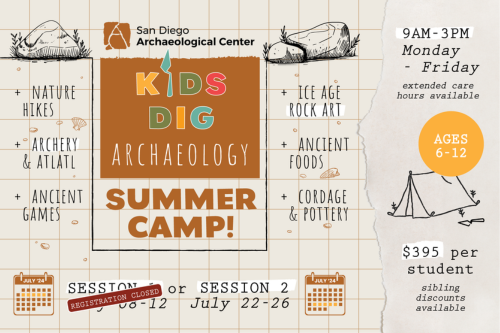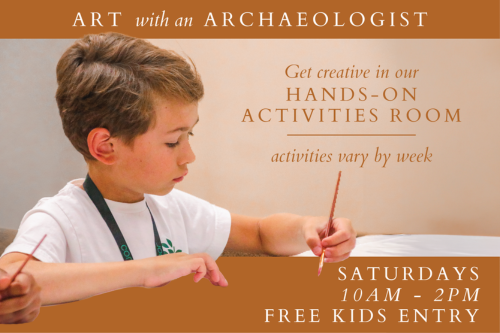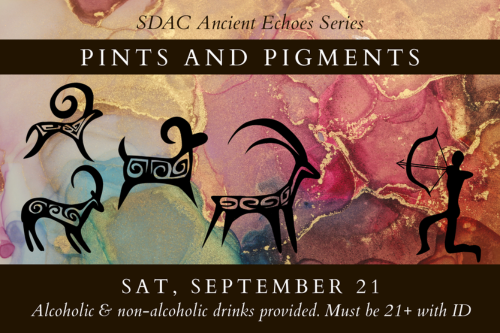SDAC Events
2nd Saturday Lecture Screenings
San Diego Archaeological Center 16666 San Pasqual Valley Road, Escondido, CA, United StatesJoin us every 2nd Saturday of the month for two screenings of our Living Room Lectures by archaeologists, experts, and authors. Lecture screenings start at 10:30 AM and 12:30 PM and are included with museum admission. No reservations needed. Seating is first come, first served. 10:30 AM - Ethnozoology of the Kumeyaay People by Richard Carrico For the Kumeyaay people of San Diego County, animals, birds, insects, and other creatures hold a special place in the cosmos and played a variety of important roles. Their embodiment is not always easily visualized because some creatures, large and small, exist in worlds not always seen by most humans, and rarely acknowledged by archaeologists. For many of the native people, there was a time when animals were actually human. In the mythic, ancient time what we now know as humans, or more correctly as mortals, did not exist. The world was inhabited by animals and by animals who were humans but not mortals—these were the Early People and some creatures could embody traits of what came to be known as the mortal humans and animals. Only later in time did the separation grow between animals and humans, and at that time the humans became mortal. This presentation will provide an analysis and discussion of the role and place of non-human creatures within the world and cosmos of the Kumeyaay people of San Diego County. 12:30 PM - The First Chicken Burrito in Western North America: Zooarchaeology of Avian Remains for the San Diego Royal Presidio by Dr. Aharon Sasson The San Diego Presidio, established in AD 1769, was the first European settlement in Upper California. Very little is known about chicken husbandry in colonial America, which makes this study the first comprehensive analysis of chicken remains in North America. Chickens are scarcely mentioned in historical accounts describing early California, and information on their sex, age, or management is rare. Small-scale poultry production, likely managed by women and children, provided California presidios with a form of subsistence independence.
Story Time with an Archaeologist
San Diego Archaeological Center 16666 San Pasqual Valley Road, Escondido, CA, United StatesJoin us on select Thursday mornings for archaeology-themed story time at the Center. Stay afterwards to explore the museum with family-friendly activities like our Archaeology Quest and Field Lab.
Historic Archery at the Center
San Diego Archaeological Center 16666 San Pasqual Valley Road, Escondido, CA, United StatesWe're stringing our bows for a spot of archery right here at the San Diego Archaeological Center! Shoot some rounds, make some new friends, and learn about how different cultures around the world crafted, hunted, and fought with bows and arrows. We'll be showcasing handmade traditional bows, arrows, quivers, and cordage, and demonstrating how to craft them out of natural materials. No previous experience required. Please bring your own gear if possible. A limited amount of gear will be available to borrow - first come, first served. Family-friendly range time: 9 AM to 10 AM Adults only: 10 AM to 12 PM Cost: $10 (includes museum admission); SDAC Members Free
Archaeology Summer Camp Session 2
San Diego Archaeological Center 16666 San Pasqual Valley Road, Escondido, CA, United StatesJoin us for an unforgettable week at the San Diego Archaeological Center’s KIDS DIG Archaeology Summer Camp! Kids will embark on a journey through time as you explore the rich history and culture of our shared human past through a variety of hands-on activities, including basketry, local hiking, honing your archery and atlatl skills, crafting pottery, ancient games, and decoding Ice Age rock art from around the world. Whether your child or grandchild is a budding archaeologist or just eager to experience the past in a whole new way, our summer camp offers something for everyone. Get ready for a week filled with adventure, discovery, and endless fun! Space is limited to 25 campers per session. Ages: 6-12. Sign up now and let the adventure begin! View our Archaeology Summer Camp page for more details and registration.
2nd Saturday Lecture Screenings
Join us every 2nd Saturday of the month for two screenings of our Living Room Lectures by archaeologists, experts, and authors. Lecture screenings start at 10:30 AM and 12:30 PM and are included with museum admission. No reservations needed. Seating is first come, first served. 10:30 AM - It’s Grind Time! Recent Investigations of the Ancestral Maya Ground Stone Tool Industry in the Mountain Pine Ridge Forest Reserve, Belize by Dr. Jon Spenard While conducting opportunistic regional survey in summer 2022 in the Mountain Pine Ridge Forest Reserve, Belize, Dr. Jon Spenard’s Rio Frio Regional Archaeological Project was informed of a series of granitic rock debitage piles nearby. Investigations revealed them to be ancestral Maya quarries and ground stone tool workshops, the first of their kind recorded anywhere in the Maya region. Naming the site the Buffalo Hill Quarries, the project mapped over a dozen extraction features (quarry pits and cut faces) surrounded by debitage piles spread over an area of approximately 16 hectares (40 acres). Aided by data from an aerial LiDAR survey of the region, the project returned in summer 2023 to finish mapping the site and conduct test excavations on an extraction locus to investigate ancestral Maya quarrying methods and techniques. In this talk, Dr. Spenard will present the results of those two field seasons, introduce more results from the LiDAR survey, and discuss the next stages of the project, including examining who the quarry workers were and how their products may have been distributed. 12:30 PM - The Skeletons of La Consentida, Oaxaca, Mexico by José “Pepe” Aguilar Twelve burials, comprising 14 individuals, were excavated from an Early Formative Period (1950–1525 BC) site called La Consentida, in Oaxaca, Mexico in 2009 and in 2012. These burials were later analyzed in 2012 and 2019. Collectively, they represent the earliest formal cemetery in the Mesoamerican west coast. Note: this presentation will show photographs of human skeletal remains.
Lecture: Geology of San Diego County – The Formative Years
This talk will focus on amazing geological forces and events from the last 200 million years that have shaped the San Diego County we see today. From regional tectonics to massive volcanism, uplift and erosion, and the many current infrastructure challenges San Diego currently faces, Mike Thacker will tell the story behind our broad mesas, dramatic coastlines, canyons, and wide valleys. Attendees will be sure to come away with a deepened understanding of and appreciation for the geological history of our unique region. Cost: Pay what you wish Advance registration is closed. Please pay at door. About the Presenter Mike Thacker is a retired Senior Staff Research and Development Scientist at Thermo Fisher Scientific. He has a B.S. in zoology from San Diego State University and studied anthropology and archaeology at University of California Santa Barbara, Palomar College, and San Diego State University. He has been a member of the Board of Trustees for the San Diego Archaeological Center since 2018 and is a volunteer teaching assistant for Palomar College archaeological excavation field school and survey programs. Mike is passionate about his home of San Diego and leads interpretive hikes for the San Dieguito River Park and San Dieguito River Valley Conservancy. His interest in geology has motivated his study of the geology of the San Diego region for the last 14 years.
Art with an Archaeologist
San Diego Archaeological Center 16666 San Pasqual Valley Road, Escondido, CA, United StatesFree admission for kids on select Saturdays! Join us for family-friendly activities in our classroom, where you can create your own art with an archaeologist, become a junior archaeologist with our miniature excavation units, and curl up with a book on our cozy reading rug. Families can also explore the museum on an Archaeology Quest and check out our Excavation Station and Field Lab. Kids 12 & under: Free; Adults: $5 (includes museum admission)
Ancient Echoes: Pints & Pigments
San Diego Archaeological Center 16666 San Pasqual Valley Road, Escondido, CA, United StatesIn this installment of our Ancient Echoes, you’ll make art the ancient way! Using natural pigments and a little human creativity, you’ll produce a one-of-a-kind paleolithic art piece (no cave required). All art materials will be provided. Tickets include two drinks per person (alcoholic and non-alcoholic options available). This event is 21+. About Ancient Echoes In our adult friendly Ancient Echoes series, we look back into the archaeological record at the origins of many of our favorite things and breaking the conceptions of their modernity. Have you ever wondered about the roots of mead, chocolate, or beer? What about the importance of art, dance, and music to Ice Age hunter-gatherers? Ancient Echoes explores these topics and more, offering an interactive experience aimed at connecting us back with our deep past. Cost: $40; SDAC Members $35 Register for Workshop Please note: Tickets are non-refundable. If you are unable to attend, your ticket(s) will be converted into a tax-deductible donation.
Kids Free San Diego
San Diego Archaeological Center 16666 San Pasqual Valley Road, Escondido, CA, United StatesCalling all Junior Archaeologists! This October, present your Kids Free San Diego coupon to receive free admission to the Center and a take-home pottery kit for kids 12 and under. Journey through the museum on a family-friendly Archaeology Quest. Use your excavation skills to uncover the past. Examine and record your findings in our field lab - just like a real archaeologist! Then continue the fun at home with a pinch pot kit. Pottery kits and museum admission are free for children 12 and under with Kids Free San Diego Coupon plus paid adult admission. To participate, visit the San Diego Museum Council website to print or download your coupon. Then present it when you visit the Center to receive free admission and pottery kits for up to two children (12 and under) with one full-price paid adult ($5+). Limit 1 pottery kit per child. Organized by the San Diego Tourism Authority with support from the San Diego Museum Council (SDMC), Kids Free San Diego is an opportunity for thousands of families to enjoy museum experiences each year. Visit SanDiego.org to view participating museums and terms. A full directory of participating venues can also be found on the SDMC website.
Kids Pottery Workshop
San Diego Archaeological Center 16666 San Pasqual Valley Road, Escondido, CA, United StatesGet creative this October! Join us for a pottery workshop and museum open house. Create your own piece of pottery to take home with you. Journey through the museum on a family-friendly Archaeology Quest. Use your excavation skills to uncover the past, then examine and record your findings in our Field Lab – just like a real archaeologist! Museum admission and pottery workshop are free for kids 12 and under. Adult museum admission: Pay what you wish (suggested $5/person).
Living Room Lecture – Recycling for Death: Coffin Reuse in Ancient Egypt and the Theban Royal Caches
VirtualIn this lecture, Kara Cooney will discuss her latest book, Recycling for Death, a meticulous study of the social, economic, and religious significance of coffin reuse during the Ramesside and early Third Intermediate periods. Funerary datasets are the chief source of social history in Egyptology, and the numerous tombs, coffins, Books of the Dead, and mummies of the Twentieth and Twenty-first Dynasties have not been fully utilized as social documents, mostly because the data of this time period is scattered and difficult to synthesize. This book is the culmination of fifteen years of coffin study, analyzing coffins and other funerary equipment of elites from the Nineteenth to the Twenty-second Dynasties to provide essential windows into social strategies and adaptations employed during the Bronze Age collapse and subsequent Iron Age reconsolidation. Cost: Pay what you wish Register for Lecture About the Author Kara Cooney is a professor of Egyptology at UCLA and Chair of the Department of Near Eastern Languages and Cultures. Specializing in social history, gender studies, and economies in the ancient world, she received her Ph.D. in Egyptology from Johns Hopkins University. Her popular books include The Woman Who Would Be King: Hatshepsut's Rise to Power in Ancient Egypt, When Women Ruled the World: Six Queens of Egypt, and The Good Kings: Absolute Power in Ancient Egypt and the Modern World. Her latest books include Ancient Egyptian Society: Challenging Assumptions, Exploring Approaches (Routledge, 2023) and Recycling for Death: Coffin Reuse in Ancient Egypt and the Theban Royal Caches (The American University in Cairo Press, August 2024).
2nd Saturday Lecture Screenings
San Diego Archaeological Center 16666 San Pasqual Valley Road, Escondido, CA, United StatesJoin us every 2nd Saturday of the month for two screenings of our Living Room Lectures by archaeologists, experts, and authors. Lecture screenings start at 10:30 AM and 12:30 PM and are included with museum admission. No reservations needed. Seating is first come, first served. 10:30 AM - Hominins, Hyenas, and Lions: Zooarchaeological Evidence for Meat Eating by Oldowan Hominins by Jennifer Parkinson The shift to increased meat consumption is one of the major adaptive changes in hominin dietary evolution and likely had important repercussions for the behavior of our early hominin ancestors. Meat-eating by hominins is well documented at Early Pleistocene (Oldowan) archaeological sites in East Africa by butchery marks on bones. While it is established that Oldowan hominins butchered mammal carcasses, there has been disagreement about whether these carcasses were hunted or scavenged, as well as disagreement about the nature of competition between hominins and large carnivores. The 2-million-year-old zooarchaeological assemblage from Kanjera South (Kenya) offers some of the earliest evidence of routine butchery of mammal carcasses by early members of the genus Homo. Bone surface modifications indicate that hominins were likely not passively scavenging from carnivore kills, but instead gaining early access to prey either through hunting or confrontational scavenging. Modern studies of lion feeding ecology are also shedding additional light on the potential for hominin-carnivore competitive interactions in the past. 12:30 PM - 21st-Century Historical Archaeology and the Next Generation of Community Engagement at the Nathan Harrison Site by Dr. Seth Mallios This talk examines how the archaeology at the Nathan Harrison Site has inspired a new generation of muralists, historians, playwrights, and others to create innovative works and continued relevance for Harrison’s evolving narratives. It offers an overview of the project, a brief biography of San Diego's first African American homesteader, an explanation of his dual identity, code-switching, and historical minstrelsy, and a discussion of the project’s case for significance beyond the dig including public exhibits, educational curricula, and creative arts.







